#Manaschi
Text
My Love for Central Asian Literature Part 1 – Abdurauf Fitrat, Abdulla Qodiry, and Cho’lpon
I’m currently working on a script for my history podcast, the Art of Asymmetrical Warfare, about three Central Asian literary giants: Abdurauf Fitrat, Abdulla Qodiry, and Abdulhamid Sulayman o’g’li Yusunov also known as Cho’lpon and it got me thinking about their influence on my historical interests, reading tastes, and writing style.
If you’re wondering why a podcast about asymmetrical warfare is talking about three Central Asian writers, you should check out my upcoming podcast episode. 😉
How I Became Interested in Central Asian Literature
My interest in Central Asia has been a long time percolating and it was just waiting for the right combination of sparks to turn it into a hyperfixation (sort of like my interest in the IRA). I went to the Virginia Military Institute for undergrad and majored in International Relations with a minor in National Security and my focus was on terrorism. So, I knew a lot about Afghanistan and Pakistan and the “classic” “terrorists” like the IRA, the FLN, Hamas, etc. and I knew of the five Central Asian states (one of my professors was banned for life from either Turkmenistan or Tajikistan and sort of life goals, but also please don’t ban me haha), but my brain bookmarked it, and I went on my merry way.
Then I went to University of Chicago for my masters, and I took my favorite class: Crime, the State, and Terrorism which focused on moments when crime, government, and terrorism intersect. This brought me back to Pakistan and Afghanistan, but this time focusing on the drug trade which led me to Uzbekistan and Tajikistan and their ties to the Taliban and it was sort of like an awakening. I suddenly had five post-Soviet states (if you know me, you’ll know I’m fascinated by post-Soviet states) with connections to the drug trade (another interest of mine) and influenced by Persian and Turkic identities. I was also writing a scifi series at the time that included a team of Russian, Eastern European, and Central Asian scientists and officers, so the interest came at the right time to hook my brain. Actually, if you buy my friend’s EzraArndtWrites upcoming “My Say in the Matter” anthology, you’ll read a short story featuring Ruslan, my bisexual, Sunni Muslim, Uzbek doctor who was inspired by my sudden interest in Central Asia.
Hamid Ismailov’s the Devils’ Dance
I wanted to know more beyond the drug trade and usually when I try to learn about a place whether it be Poland, Ireland, or Uzbekistan, I go to their music and literature. This led me to one of my all-time favorite writers Hamid Ismailov and my favorite publishers Tilted Axis Press.
Tilted Axis Press is a British publisher who specializes in publishing works by mainly Asian, although not only Asian writers, translated into English. They publish about six books a year and you can purchase their yearly bundle which guarantees you’ll get all six books plus whatever else they publish throughout the year. I’ve purchased the bundle two years in a row, and I haven’t regretted it. The literature and writers you’re introduced to are amazing and you probably won’t normally have found unless you were looking specifically for these types of books.
Hamid Ismailov is an Uzbek writer who was banished from Uzbekistan for “overly democratic tendencies”. He wrote for BBC for years and published several books in Russian and Uzbek. A good number of his books have been translated into English and can be found either through Tilted Axis or any other bookstore/bookseller. Some of my favorites include Dead Lake, the Manaschi, the Underground, and the book that inspired everything the Devils’ Dance.
Tilted Axis’ translation of The Devils’ Dance came out the same year I was working on my masters, and I bought it because it is a fictional account of Abdulla Qodiriy’s last days while in a Soviet prison. He goes through several interrogations and runs into his fellow writers and friends: Fitrat and Cho’lpon. Qodiriy is written as detached from events while Cho’lpon comes across as very sarcastic, as if this is all a game, and Fitrat is interestingly resigned to the Soviet’s games but seems to have some fight in him. Qodiry distracts himself from the horrors around him by thinking about his unwritten novel (which he really was working on when he was arrested by the NVKD). His novel focuses on Oyxon, a young woman forced to marry three khans during the Great Game. His daydreaming takes a power of its own and he occasionally slips back to talk with historical figures such as Charles Stoddart and Arthur Connolly-two British officers who were murdered by the Khan of Bukhara (not a 100% convinced they didn’t have it coming).
We spend half of the narrative with Qodiriy and the other half with Oyxon as she is taken from her home and thrown into the royal court of Kokand’s khans where she is raped and mistreated and has to survive the uncertain times of Central Asia during the Great Game. She is passed from Umar, the father, to Madali, the son, to the conquering Khan of Bukhara, Nasrullah who eventually murders her and her children. From a historical perspective, I have a lot of questions about Nasrullah because a lot of sources write him off as a cruel tyrant and nothing more which usually means there’s more…Before Oyxon and Qodiriy are taken to their deaths, there is a poignant scene where the two timelines merge into one that will stay with you long after the novel is over.
The book is a masterpiece exploring themes of colonialism, liberty, powerlessness in face of overwhelming might, the power of the human mind and spirit, the endurance of ideas, even when burned and “lost”, as well as being a powerful historical fiction about two disruptive periods in Central Asian history. It’s also a love letter to the three literary giants of Uzbek fiction: Abdurauf Fitrat: a statesmen who crafted the Turkic identity of Uzbekistan, a playwright and statesmen, Abdulla Qodiriy who created the first Uzbek novel (O’tgan Kunar which was recently translated by Mark Reese and can be bought in most bookstores), and Cho’lpon who created modern Uzbek poetry (you can buy his only novel Night translated by Christopher Fort and a collection of his poems 12 Ghazals by Alisher Navoiy and 14 Poems by Abdulhamid Cho’lpon translated by Andrew Staniland, Aidakhon Bumatova, and Avazkhon Khaydarov in any bookstore).
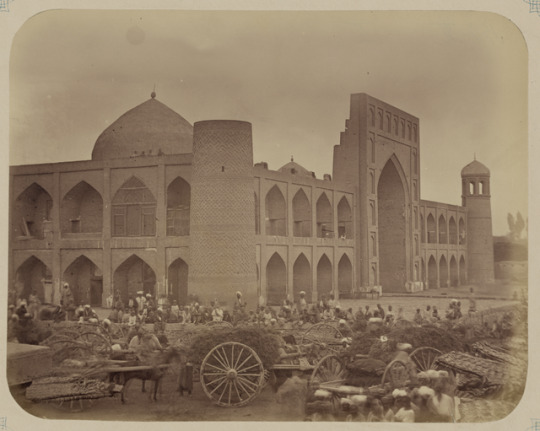
City of Kokand circa 1840-1888, thanks to Wikicommons
All three men were Jadids (modern Muslim reformers) who worked with the Bolsheviks to stabilize Central Asia, helped create the borders of the five modern Central Asian states, and were murdered by the Soviets during Stalin’s Great Purge of the 1930s. It was illegal to publish their work until the glasnost. Check out my history podcast to learn more about the Jadids and the Russian and Central Asian Civil Wars.
From a literary perspective however, Ismailov wrote the Devils’ Dance similarly to Qodiriy’s own O’tgan Kunlar and Cho’lpon’s Night (whereas Ismailov’s other books: Dead Lake and the Underground are more Soviet era Central Asian literature and his newest book the Manaschi is more post-Soviet). Like Qodiriy and Cho’lpon, Ismailov writes about MCs who are not the master of his own fate, but instead are going through the motions of a fate already written, one of his MCs is a woman unfairly caught in a misogynistic system that uses women as it sees fit (although I would argue that Hamid gives his women characters more agency than either Qodiry and Cho’lpon), and he writes about the corruption and inefficiencies of whatever government agency is in control at the time – whether it be a Russian, a Khan, or an indigenous agent of said government. All three books end in death, although only Cho’lpon’s Night and Ismailov’s the Devils’ Dance end in a farce of a trial. Even stylistically Ismailov mimics the rich and dense language of Qodiriy whereas I find Cho’lpon’s style crisper although no less rich for it.
Abdurauf Fitrat’s Downfall of Shaytan
While Ismailov led me down a historical rabbit hole which is captured on my history podcast, I also wanted to see if any of Fitrat’s, Qodiry’s, or Cho’lpon’s work had been translated into English.
So far, I can’t find anything by Fitrat except excerpts in the Devils’ Dance and Making Uzbekistan by Adeeb Khalid (one of my all-time favorite history books by one of my favorite scholars who also happens to be very kind and patience and I still can’t believe I interviewed him for my podcast).
Fitrat wrote a specific play I really want to read called Shaytonning Tangriga Isyoni which Dr. Khalid translated as Shaytan’s Revolt Against God. According to the summary provided by Dr. Khalid it is a challenging take on the Islamic version of Satan’s downfall.
According to Dr. Khalid, in Islamic cosmology God created angels from light and jinns from fire and they could only worship God. When God made Adam, He commanded all angels and jinn to bow before him. Azazel (who would become Shaytan) refused claiming he was better than Adam who was made out of clay. He was cast out of heaven and became Shaytan/Iblis.
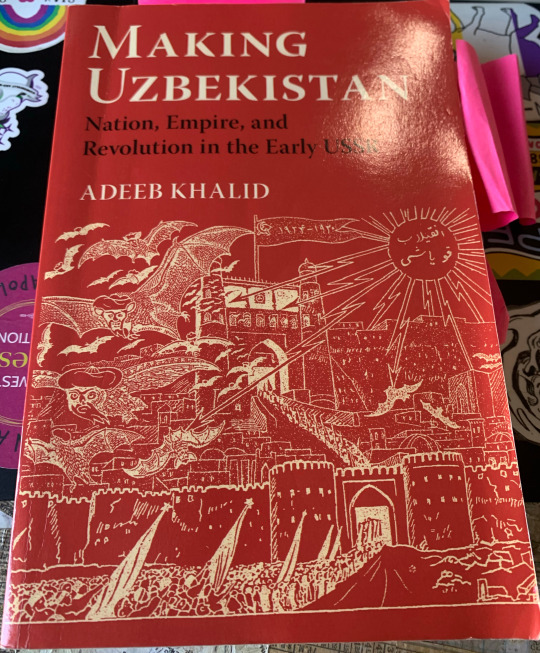
Fitrat reimagines Shaytan’s defiance as heroic. He is disgusted by the angels’ submissive nature and God’s ability to create anything and yet he chooses to create servants. Azazel has seen God’s plan to create another being out of clay and have the angels worship him as well, which Azazel sees as a betrayal on God’s part. Gabriel, Michael, and Azrael try to convince Azazel to see reason and instead he brings his grievance to the other angels who are confused. God intervenes and the angels give in, but Azazel continues to defy God. God strips him of his angelic nature, and he turns into Shaytan who warns Adam of God’s treacherous nature and vows to free him and all other creatures from God’s trickery.
Doesn’t it sound amazing?! Fitrat has outdone Milton in terms of completely overturning God’s and Satan/Shaytan’s rules (also no wonder he was marked for execution right? Complete firebrand and pain in the ass (and I mean that with love)) and I really want to read it. So, either someone needs to translate this into English, or I need to learn Persian/Uzbek, which ever happens first, haha (judging on how my Russian is going…)
Abdulla Qodiry’s O’tgan Kunlar
While I can’t find any of Fitrat’s work in English, there have been two translations of Abdulla Qodiriy’s novel and the first ever Uzbek novel O’tgan Kunlar. In English, the title translates as Days Gone By or Bygone Days. There are two translates out there: Days Gone By translated by Carol Ermakova, which is the version I’ve read, and Otgun Kunlar by Mark Reese, which I haven’t read yet but I’ve heard him speak (and actually spoke to him about his translation – thank you Oxus Society) so you can’t go wrong with either one.
O’tgan Kunlar is an epic novel set in the Kokand Khanate in the 18th century and is about Otabek and his love Kumush. There’s also a corrupt official, Hamid who hates Otabek because Otabek is a former who wants to change the society Hamid benefits from. Hamid tries to get Otabek killed for treason because of his reformist believes, but the overthrow of the corrupt leader of Tashkent (who Otabek worked for) saves Otabek’s life. However, the corrupt leader’s machinations convince the Khan to declare war against the Kipchaks people, who are massacred. Otabek and his father vehemently disagree with the massacre of the Kipchaks.
Once Otabek is released and gets revenge against Hamid, he marries Kumush without his parent’s approval and is torn between the two families. His mother hates Kumush and forces him to take a second wife, Zainab. Obviously, things go terribly wrong as Otabek doesn’t even like Zainab and Kumush doesn’t know how to feel about her husband having a second wife. Zainab hates her position within the household and eventually poisons Kumush.

Abdulla Qodiriy thanks to Wikicommons
O’tgan Kunlar is considered to be an Uzbek masterpiece that is central to understanding Uzbekistan. Not only is it a great tragic love story, but it also highlights some of the things Qodiriy was thinking about as he engaged with other Jadids. Just as Otabek argued for reforms especially in the educational, social, and familial realms, the Jadids were making the same arguments. We can also see the Jadid’s struggle with the ulama and the merchants in Otabek’s struggle with Hamid. Qodiry attempts to capture the struggle women went through by writing about the horrors for arrange marriages and polygamy, but Kumush is an idealized version of a woman. She is the pure “virgin” like Margarete from Faust while the other two female characters; Otabek’s mother and Zainab are twisted, bitter woman who hurt those they “love”. One could argue they’ve been corrupted by the society they live in, but they also lack the depth of Otabek and even his father.
One of the most interesting parts of the novel is the massacre of the Kipchaks because it is written as the horror it was and both Otabek and his father condemn the action. His father even claims that there is no sense if hating a whole race for aren’t we all human? Central Asia is a vast land full of different peoples who share common, but divergent histories and while these differences have led to massacres, there have also been moments of living peacefully together. It’s interesting that Qodiriy would pick up that thread and make it a major part of his novel because this was written during the Russian Civil Wars and the attempts to create modern states in Central Asia. The Bolsheviks really pushed the indigenous people of Central Asia to create ethnic and racial identities they could then use to better manage the region and so one wonders if Qodiriy is responding to this idea of dividing the region instead of uniting it.
Cho’lpon’s Night
While O’tgan Kunlar is a beautiful book and Qodiriy is a masterful writer, I prefer Cho’lpon’s Night (although don’t tell anyone). Night was supposed to be a duology, but Cho’lpon was murdered before he could finish the second book. Cho’lpon wrote Night in 1934, after years of being attacked as a nationalist. It was a seemingly earnest attempt to get into the Soviet’s good graces. Instead, he would be murdered along with Qodiriy and Fitrat in 1938.
Night is about Zebi, a young woman, who is forced to marry the Russian affiliated colonial official Akbarali mingboshi. The marriage is arranged by Miryoqub, Akbarali’s retainer. Akbarali already has three wives and, like in O’tgan Kunlar, adding a new wife causes lots of problems in the household. Meanwhile Miryoqub falls in love with a Russian prostitute named Maria and they plan to flee together. While they are fleeing they met a Jadid named Sharafuddin Xo’Jaev and Miryoqub becomes a Jadids. Meanwhile Akbarali’s wives conspire against Zebi and attempt to poison her but she unwittingly gives it to Akbarali instead. Zebi is arrested and found guilty of murdering her husband and sentenced to exile in Siberia. The book ends with Zebi’s father, who encouraged her marriage to Akbarali, is driven made by his daughters fate and murders a sufi master while Zebi’s mother goes mad, wandering the streets and singing about her daughter.
Like Qodiriy, Cho’lpon is interested in examining governmental corruption, the need for reform, and women’s plight, but Cho’lpon is less resolute than Qodiriy. Cho’lpon’s novel is constructed similar to poetry: an indirect attempt to capture something that is concrete only for a moment.
His characters are own irresolute or ignorant of important pieces of information meaning they are never truly in full control of their fates. Even Miryoqub’s conversion to Jadidism is to be understood as a step in his self-discovery. In Cho’lpon’s world, no one is ever truly done discovering aspects of themselves and no one will ever have true knowledge to avoid tragedy.

Cho'lpon courtesy of Wikicommons
It is interesting to read Night as Cho’lpon’s own insecurity and anxiety about his own fate and the fate of his fellow countrymen as Stalin seemingly paused persecuting those who displeased him. While Qodiriy crafted and wrote O’tgan Kunlar in the 1920s, which were unstable because of civil war, but promised something greater as the Jadids and Bolsheviks regained control over the region, Cho’lpon wrote Night during the height of Stalin’s Great Terror, most likely knowing he would be arrested and executed soon.
Both novels are beautifully written historical novels about a beautiful region, but I prefer Cho’lpon’s poetic prose and uncertainty.
Conclusion
Reading the works of Fitrat, Qodiriy, and Cho'lpon not only introduced me to a history I knew little about, but also introduced me to a whole literature I never knew existed. The books mentioned in this blog post are beautiful pieces literature and will challenge how you see the world and how much literature we miss out on when we don't read beyond authors who work in our native tongues.
The canon of Central Asian literature is immense, with only a handful of books and poems translated into English. I hope more works are translated so other people can engage with these books and poems and learn about these writers and the circumstances that shaped them. And, if you haven't, go check out Tilted Axis who are doing amazing work translating books so people can engage with them.
If you're enjoying this blog, please join my patreon or donate to my ko-fi
#central asian history#central asian literature#abdurauf fitrat#abdulla qodiriy#cho'lpon#O'tgan Kunlar#Days Gone by#Night#Hamid Ismailov#the Devils' Dance#Soviet Union#Soviet Central Asia#Uzbekistan
13 notes
·
View notes
Photo

I've been in love with Hamid Ismailov since I read his The Devil Dance. His writing is never ever easy to be read or to be understood and often require a reread but they're always worth reading. Manaschi is without exception. It follows a young man- a radio presenter who returns to his home village in the border between Kyrgyzstan and Tajikistan after the death of his uncle. He is then inspired by a dream to become a Manaschi, a reciter of the epic poem, Manas. This brings a series of long-held rivalries between the neighbouring communities flare up. The readers will also giggle while reading the part where the local will have to interact with the Chinese community with their limited ability to communicate. You will see also a bit if the cultural things in which they consider their hunting eagles or horses as their family members. Manaschi to me comes as the story that covers various things: tradition and modernity, shamanism and Islam, Turkish and Farsi. Throughout the book, Ismailov shows these narratives shapes our identity, how culture is created or destroyed, and how boundaries can be reinforced or transcended. A book to enjoy, both for the story and the unfamiliar culture of the setting. Des ✨ #bookishindonesia #bookaholic #bookstagram #bookstagramindonesia #bibliophile #bookreview #bookreviewer #booknerd #bookaddict #bookblogger #bookaesthetic #bookblogger #bookenthusiast #booksbooksbooks #descalibrary #descareading2022 #fictionbook #literaturejunkie #nonfiction #igreads #igbook #instaread #instabooks #ReadTheWorld2022 #riotgrams #BookstagramReels #Uzbekistan #ReadTiltedAxis #HamidIsmailov #Manaschi (at Bangkok Thailand) https://www.instagram.com/p/Cff7idwLaoM/?igshid=NGJjMDIxMWI=
#bookishindonesia#bookaholic#bookstagram#bookstagramindonesia#bibliophile#bookreview#bookreviewer#booknerd#bookaddict#bookblogger#bookaesthetic#bookenthusiast#booksbooksbooks#descalibrary#descareading2022#fictionbook#literaturejunkie#nonfiction#igreads#igbook#instaread#instabooks#readtheworld2022#riotgrams#bookstagramreels#uzbekistan#readtiltedaxis#hamidismailov#manaschi
0 notes
Note
Are there any books written by casians you'd reccomend? Ik i could look them up, but i was wondering if you had any favourites. Hope you're doing well!
yes! so, looking at casian literature/fiction, and not informative literature to learn about casia, here are some of the popular books from my region! due to me being kyrgyz/kazakh, all these books will be kyrgyz, with some kazakh influence, because i truly don’t know about the other nation’s literature as well as i do ours. central asia as a whole is an incredibly diverse melting pot that has been at the center of extreme cultural exchange and trade for centuries, so each region varies incredibly. therefore, i’m only going to speak for what i know. this area is definitely very hard to navigate for english-speakers; the vast majority of casian literature is documented orally and passed down through our storytellers, like the kyrgyz manaschi, so finding written documentation, let alone translated, is difficult. you’ll have a much easier time of it if you can read chinese or russian, because those are the most common languages that casian literature is translated into
having said all that, here are the most popular books! probably the most famous kyrgyz novel, Jamilia by Chynggyz Törökulovich Aytmatov. Aytmatov is by far one of kyrgyzstan’s most influential writers, so any work by him is a great example of our literature! some of his most famous works are The White Ship, Farewell, Gyulsary!, and The Day Lasts More Than a Hundred Years. some other notable mentions of his works are The First Teacher, The Girl with the Red Scarf, The Place of the Skull, and Face to Face. as far as i’m aware, the majority of these should be translated into english, but i’m not certain. one of the leading professors in central asian studies, Iraj Bashiri, wrote many literary analyses of Aytmatov’s works (in english!), which i believe to be absolutely crucial for the western understanding and appreciation of kyrgyz literature. You can find them here!
another writer to look into is the aqyn Jolon Mamytov. as he is an aqyn,,,, you will definitely need to know some basic kyrgyz or russian to read his works, as they don’t translate well to other languages. if you do have a grasp of either of these languages, i would definitely recommend Жүз жашка тол, кылым, Суунун өмүрү, and Эр Чилтен. Moldo Nïyaz is one of the earliest credited writers, with his writings being in the Chagatai language that was used for central asian written works until its extinction in the 20th century, when the perso-arabic alphabet we traditionally used was converted to the latin alphabet, which was then replaced by the cyrillic alphabet in the 1940s. Nïyaz's work is a great look at ancient kyrgyz beliefs and literature, so if you can read kyrgyz/russian, they would be great to look at!
for foundational kyrgyz literature, you might have some trouble finding english documentation of these, but the Manas and Kojojash are absolutely the most influential sources of kyrgyz culture. they’re not books or novels, they’re epic poems, which is why i hesitate to recommend them, but they are the foundation of our culture and beliefs! so, if you are very interested in learning about kyrgyz literature, they are absolutely fantastic resources that i would highly recommend. additionally, you can find recordings of our oral storytellers (Manaschi) who have passed down the Manas through generations on spotify or youtube. the Manas is performed in a sing-song style with instruments, and these individuals often train their entire lives to be a true Manaschi that can convey the spirit of the Manas! if you want to learn more, then i linked two websites in this post here that are great compilations of central asian music, dance, literature, practices, education, politics, and really anything else you can think of. you can search through and see many recommended titles!
27 notes
·
View notes
Text
Folk Music of Central Asia
https://youtu.be/-hYL4JWd5AMThis is not meant to lump all folk music from the 5 Stans but some things are similar but different. First encounter with folk music in Central Asia was at the wonderful Kazakh Museum of Folk Musical Instruments. This enjoyable museum has a fine collection of traditional instruments from wooden harps and horns, bagpipes including a very old one made from sheep’s stomach (below) to
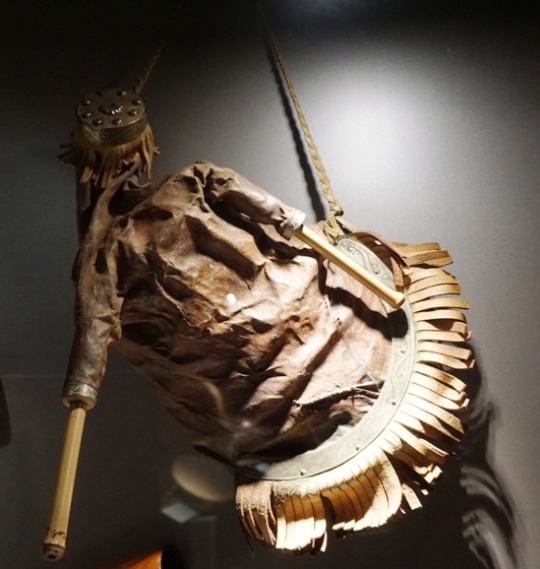
ornately decorated lute-like two-stringed dombras (below)

and viola like kobyz
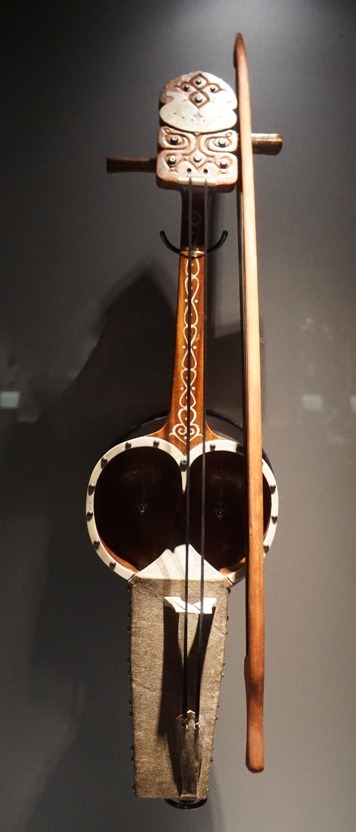
Some of the instruments were so old and some were obviously family heirlooms. To see more of the collection, click https://photos.app.goo.gl/yjkvu7R4o5F2YHzW9
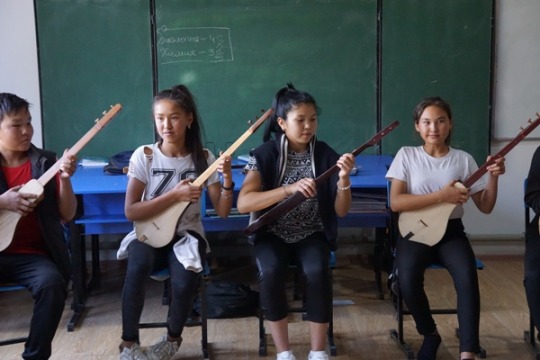
The next encounter was seeing a performance by the Grade 8 students at Bilimkana private school we visited in Kalmak-Ashu, a village in Chon-Kemin valley in Kyrgyzstan. The piece played was about galloping horses and one can definitely hear it! Here’s the link to the video: https://youtu.be/9811TJdz74k
In Bishkek, we were treated to a performance by the Kyrgyzstan Folklore Company.

To see some of the performances, see
https://youtu.be/IPXhwTb9WUk
https://youtu.be/_1W_eKyFDGw
https://youtu.be/NNHMi_0whJw
https://youtu.be/ye-K2nP-8AY
As a bonus, we were also treated to a short recital of one of the epics of Manas - a traditional Kyrgyz poems of the Manas, his descendants and their exploits, events that coincide with the history of the region in 17th Century. People who specialize in reciting the epic are called Manaschi (Kyrgyz: Манасчы). Manaschis who tell the tale in a melodic chant, most likely going into a trance and unaccompanied by musical instruments.
https://youtu.be/O2WFxh0c83A
In Uzbekistan, we visited a music shop and the owner gave us a taste of some of the instruments.
https://youtu.be/-hYL4JWd5AM
https://youtu.be/BZcdoMpopSQ
https://youtu.be/ER7X7rziqrc

All in all it was good to learn more about music in Central Asian.
1 note
·
View note
Photo
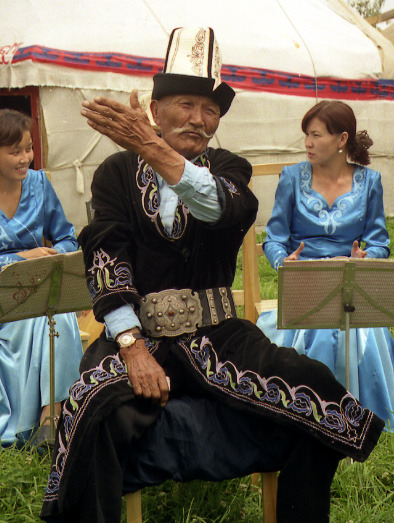
Public domain photo of a manaschi in Karakol, Kyrgyzstan
0 notes
Photo

The epic "Manas" is the most famous example of the culture of Kyrgyzstan and (possibly) the longest epic poem in the world. Twenty times longer than the Odyssey, this epic tells the story of the life of the warrior Manas, as well as the adventures of his son and grandson. This story from generation to generation was kept and retold by special people, the storytellers of the epic - manaschi (manaschi). The epic was recorded in the 1800s, with the first full version published in the 1920s. Manas has been translated into many languages and published in the Soviet Union and abroad. At the beginning of the poem, it is said about the warrior Manas, who was born in the Talas region. At the center of the narrative is his attempt to reunite warring tribes and create a homeland for his people. His wise wife from Samarkand named Kanykei and advisor Bakai are also important heroes of the poem. In the second and third parts of the poem, the main characters are the son of Manas Semetey and his grandson Seytek. There is a mausoleum in Talas, where, possibly, the remains of Manas himself are kept. During the 1969 restoration, the skeleton of a man was found there, however, the inscription on the mausoleum says that it was erected for a woman. The epic just says that Kanykei and Bakai bury Manas under a false name so that his grave would not be ravaged by enemies, which was widely practiced in those days. It is not so important whether Manas actually existed, because his influence on modern Kyrgyzstan is enormous. The official flag of Kyrgyzstan depicts 40 sun rays, symbolizing 40 tribes that united thanks to Manas. Throughout Kyrgyzstan, many places are named after this hero, from Manas International Airport to Manas Avenue and the Kyrgyz-Turkish Manas University in Bishkek. Manas Peak 4482 meters is the highest peak of the Talas mountain range. There is even an asteroid 3349 Manas, discovered by a Soviet astronomer in 1979. www.KyrgyzGuides.com #talas #kyrgyzstan #centralasia #silkway #silkroad #kyrgyzguides #centralasiaguides #history #epos #manas #museum #hero #trilogy https://www.instagram.com/p/CSOu4CaIOIr/?utm_medium=tumblr
#talas#kyrgyzstan#centralasia#silkway#silkroad#kyrgyzguides#centralasiaguides#history#epos#manas#museum#hero#trilogy
1 note
·
View note
Text
I See You

Name: Kyrgyzstan
Capital: Bishkek
Motto: No offical motto
Location: Central Asia
Population: 6,132,932 (2018)
Religion: Islam, Christianity (Russian Orthodox)
Climate: Varieties regionally
Language(s) Spoken: Kyrgyz and Russian
Currency: Sumo
Independence Day: August 31, 1991
Flag meaning: The red field stands for "bravery and valor. The sun epitomizes peace and prosperity, while its 40 rays stand for the number of tribes united by Manas to fight against the Mongols, as well as the number of followers he had.
The centre of the sun features a stylized illustration of the roof (tunduk) atop a traditional Kyrgyz tent (yurt) when viewed from the interior. Although these tents are less commonly used today, its incorporation into the flag is meant to symbolize the "origin of life", the "unity of time and space", as well as the people's "hearth and home" and their history.
Brief History
The Kyrgyz state reached its greatest expansion after defeating the Uyghur Khaganate in 840 A.D. From the 10th century the Kyrgyz migrated as far as the Tian Shan range and maintained their dominance over this territory for about 200 years.
In the twelfth century the Kyrgyz dominion had shrunk to the Altay Range andSayan Mountains as a result of the Mongol expansion.
With the rise of the Mongol Empire in the thirteenth century, the Kyrgyz migrated south.
The Kyrgyz peacefully became a part of the Mongol Empire in 1207.
The descent of the Kyrgyz from the autochthonous Siberian population, on the other hand, is confirmed by recent genetic studies.
Because of the processes of migration, conquest, intermarriage, and assimilation, many of the Kyrgyz peoples who now inhabit Central and Southwest Asia are of mixed origins, often stemming from fragments of many different tribes, though they now speak closely related languages.
Kyrgyz tribes were overrun in the 17th century by the Mongols, in the mid-18th century by the Manchurian Qing Dynasty, and in the early 19th century by the Uzbek Khanate of Kokand.
In the late nineteenth century, the eastern part of what is today Kyrgyzstan, mainly Issyk-Kul Region, was ceded to Russian Empire through the Treaty of Tarbagatai between China and Russia.
The Russian takeover was met with numerous revolts against Tsarist authority, and many of the Kyrgyz opted to move to the Pamir Mountains and Afghanistan.
The suppression of the 1916 rebellion against Russian rule in Central Asia caused many Kyrgyz later to migrate to China.
Soviet Kyrgyzstan
Soviet power was initially established in the region in 1919, and the Kara-Kyrgyz Autonomous Oblast was created within the Russian SFSR. On 5 December 1936, the Kirghiz Soviet Socialist Republic was established as a full republic of the Soviet Union.
Many aspects of Kyrgyz national culture were retained despite the suppressionof nationalist activity under Joseph Stalin, who controlled the Soviet Union fromthe late 1920s until 1953.
The Republic's press was permitted to adopt a more liberal stance and toestablish a new publication, Literaturny Kirghizstan, by the Union of Writers.
According to the last Soviet census in 1989, ethnic Kyrgyz made up only 22% ofthe residents of the northern city of Frunze, while more than 60% wereRussians, Ukrainians, and people from other Slavic nations.
On 15 December 1990, the Supreme Soviet voted to change the republic'sname to the Republic of Kyrgyzstan.
Despite these political moves toward independence, economic realities seemedto work against secession from the Soviet Union.
In a referendum on the preservation of the Soviet Union in March 1991, 88.7% of the voters approved the proposal to retain the Soviet Union as a "Renewedfederation".
Secessionist forces pushed Kyrgyzstan's independence through in August of thatsame year.
After the coup collapsed the following week, Akayev and Vice President German Kuznetsov announced their resignations from the Communist Party of the Soviet Union, and the entire bureau and secretariat resigned.
This was followed by the Supreme Soviet vote declaring independence from theSoviet Union on 31 August 1991 as the Republic of Kyrgyzstan.
Geography
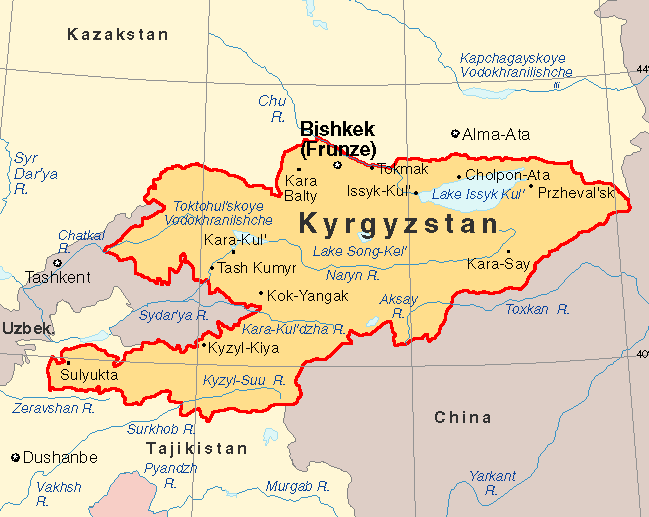
Kyrgyzstan is a landlocked country in Central Asia, bordering Kazakhstan, China, Tajikistan and Uzbekistan. The mountainous region of the Tian Shan covers over 80% of the country (Kyrgyzstan is occasionally referred to as "the Switzerland of Central Asia", as a result), with the remainder made up of valleys and basins.

Issyk-Kul Lake, or Ysyk-Köl in Kyrgyz, in the north-eastern Tian Shan is the largest lake in Kyrgyzstan and the second largest mountain lake in the world after Titicaca.

The highest peaks are in the Kakshaal-Too range, forming the Chinese border.
Kyrgyzstan has significant deposits of metals including gold and rare-earth metals.
The second city is the ancient town of Osh, located in the Fergana Valley near the border with Uzbekistan.
The principal river is the Kara Darya, which flows west through the Fergana Valley into Uzbekistan.
Across the border in Uzbekistan it meets another major Kyrgyz river, the Naryn.
The Chu River also briefly flows through Kyrgyzstan before entering Kazakhstan.
Culture

The nation's largest ethnic group are the Kyrgyz, a Turkic people, who comprise 73.2% of the population.
Other ethnic groups include Russians concentrated in the north and Uzbeks living in the south.
Small but noticeable minorities include Dungans (Muslim Chinese), Uyghurs, Tajiks, Kazakhs, and Ukrainians and other smaller ethnic minorities.

The Kyrgyz have historically been semi-nomadic herders, living in round tents called yurts and tending sheep, horses and yaks. This nomadic tradition continues to function seasonally as herding families return to the high mountain pasture (or jailoo) in the summer.
Dress
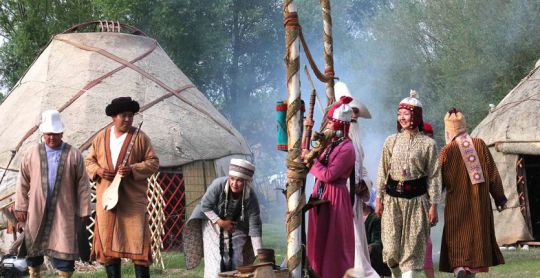
The main materials for making clothes were coarse wool, felt, fur and leather.
The noble families could afford expensive clothes made of fabrics from thetowns of the Great Silk Road. The outerwear is called "Chapan".
In winter nomads wore sheepskin coat named "Ton" and fur coats "Ichiks" made of fox fur, wolf or lynx.

Men wore wide trousers made of leather or suede, embroidered with colored threads, shirts and felt robe.
Married women wore skirts with fur and patterned embroidery.
Literacy
Manas is an orally transmitted epic poem told by manaschis, and the name of the epic's eponymous hero. The poem, with close to half a million lines, is twenty times longer than Homer's Odyssey, and one of the longest epics in the world. It is a patriotic work recounting the exploits of Manas and his descendants and followers, who, according to tradition, fought against the Chinese and Kalmyks in the 9th century to preserve Kyrgyz independence.
(Here’s Manas poem if you’re interested in reading)
Chingiz Aytmatov is often referred to as a national writer of Kyrgyzstan. Kenesh Jusupov is also a prominent Kyrgyz writer
Some phrases in Kyrgz ( Кыргыз тили) + their English meaning
Welcome - Кош келиңиз! (Kosh kelingiz!) - sg/frm
Кош келиңиздер! (Kosh kelingizder!) - pl/frm
Hello (General greeting) - Салам! (Salam!) - sg/inf
Саламатсыңбы! (Salamatsyngby!) - sg/inf
Саламатсыңарбы! (Salamatsyngarby!) - sg/inf
Саламатсызбы! (Salamatsyzby!) - sg/frm
Саламатсыздарбы! (Salamatsyzdarby!) - pl/frm
Reply - Саламатчылык! (Salamatchylyk) - reply/frm
Алейкум Ассалам! (Aleykum Assalam!) - reply
Саламат! (Salamat!) - short reply
Саламатчылык! (Salamatchylyk) - full reply
How are you?- Кандайсың? (Kandaysyng?) - sg/inf
Кандайсыз? (Kandaysyz?) - sg/frm
Сиздин ишиңиз кандай? (Sizdin ishingiz kanday?) - sg/frm
Ден соолугуңуз кандай? (Den soolugunguz kanday?) - sg/frm
Жакшысыңбы? (Jakshysyngby?) - sg/inf
Жакшысызбы? (Jakshysyzby?) - sg/frm
Reply to 'How are you?- Жакшы, рахмат. Өзүңүз кандайсыз?(Jakshy, rakhmat)
Özüngüz (kandaysyz?) - sg/frm
What's your name?- Сенин атың ким? (Senin atyng kim?) - sg/inf
Сиздин атыңыз ким? (Sizdin atyngyz kim?) - sg/frm
My name is … - Менин атым ... (Menin atym ...)
Where are you from?- Сиз кайдан келдиңиз? (Siz kaydan keldingiz?) - sg/frm
I'm from … - Мен ...-дан келдим (Men ...-dan keldim)
Pleased to meet you- Таанышканыма кубанычтамын! (Taanyshkanyma kubanychtamyn!)
Good morning- Кутмандуу таңыңыз менен! (Kutmanduu tanyngyz menen!) - sg/frm
Good afternoon- Кутмандуу күнүңүз менен! (Kutmanduu kününgüz menen!) - sg/frm
Good evening- Кайырлуу кеч! (Kayryluu kech!)
Good night- Түнүңүз бейпил болсун! (Tününgüz beypil bolsun!) - sg/frm
Goodbye- Көрүшкөнчө (Körüshkönchö) - inf
Саламатта бар (Salamatta bar) - sg/inf (if a person leaving)
Саламатта барыңыз (Salamatta baryngyz) - sg/frm
Саламатта баргыла (Salamatta bargyla) - pl/inf
Саламатта барыңыздар (Salamatta baryngyzdar) - pl/frm
Cuisine
The cuisine of Kyrgyzstan is similar in many respects to that of its neighbors, particularly Kazakh cuisine.
Traditional Kyrgyz food revolves around mutton (Goat meat) and horse meat, as well as various dairy products.
Kyrgyzstan is home to many different nationalities and their various cuisines.
In larger cities, such as Bishkek, Osh, Jalal-Abad, and Karakol, various national and international cuisines can be found.
On the road and in the villages, the cuisine tends to be standard Kyrgyz dishes, liberally flavored with oil or sheep fat, which are considered both delicious and healthy by the local population.

Pilaf (paloo) is the national dish in Kyrgyzstan. Green tea is considered the national beverage.
Interesting Facts about Kyrgyz Republic
1. Kyrgyzstan’s walnut forests are among the world’s largest natural forests of this type.
2. “Manas,” a narration of the migration of the Kyrgyz under the Manas leadership, is one of the world’s longest epics.
3. The city of Osh was an important commercial center in the 10th century as part of the Silk Road, the trade route between China and Europe.
4. The Inylchek Glacier of Kyrgyzstan is one of the largest glaciers in the world.
5. The name Kyrgyz is derived from the Kyrgyz word for “forty.” It is a possibility that the people of Kyrgyzstan came from forty families or clans.
6. The Kyrgyz were one of the groups who raided the borders of China and created the need for the construction of the Great Wall.
7. Be careful in the cities of Osh, Jalal-Abad, and Bishkek. The roads and sidewalks are filled with holes and uncovered sewers.
8. Kyrgyzstan is one of the few countries that have a currency with a denomination of 3 som.
9.The most famous national drink is horse milk “kumyz”
10.Illegal, but still practiced, is the tradition of bride kidnapping
It is debatable whether bride kidnapping is actually traditional. Some of the confusion may stem from the fact that arranged marriages were traditional, and one of the ways to escape an arranged marriage was to arrange a consensual "kidnapping."
watch Geograohy Now’s video for anything I’ve missed
Questions of the day (QOTD)
- Have you heard of Kyrgyzstan before? If not whats your favorite thing about it?
- Do you speak/understand Russian or think of adding Kyrgyz to your target language list?
- Which country should be next in I See You project?
(To read my previous post about Vanuatu)
PLEASE DO INFORM ME IF YOU FIND ANY MISTAKE
#ISY mini project#langblr#Languageblr#languages#kyrgyzstan#kyrgyz republic#I See You#asian#asia#central asia#geography#History#polyglot
5 notes
·
View notes
Text
On Xinjiang, Kazakhstan and Kyrgyzstan Bend to Beijing’s Will
Each story is heartbreaking: The ethnic Kyrgyz pupil from Xinjiang who served revive a basic Kyrgyz dance went back to Xinjiang in Oct 2018 and under no circumstances returned to his reports in Kyrgyzstan the young Turkish Uyghur girl who had been dwelling in Urumqi with her moms and dads and returned to Turkey to renew her visa only to get news that though she was absent, her mom and dad experienced been detained two small children, 7-a long time aged and 6-a long time-previous, with Turkish citizenship traveled to Xinjinag with their mother on her Chinese passport and have not been read from because the 75-12 months aged father of a California man, with lawful status to continue to be in the United States, returned to Xinjiang and disappeared.
With estimates now suggesting that as several as 1.5 million folks — mostly Uyghurs, but also other Muslim minorities in Xinjiang like Kazakhs and Kyrgyz — have been detained in sprawling “re-education” camps, governments all over the environment have wrestled with how to respond. People that have responded have struggled to do so effectively.
Various latest studies emphasize this actuality. I’ll target on the Central Asian international locations of Kazakhstan and Kyrgyzstan (but motivate you to examine this current Buzzfeed report on Turkish citizens detained in Xinjiang.)
Taking pleasure in this post? Click below to subscribe for complete accessibility. Just $5 a month.
In a dispatch for Foreign Plan, Gene A. Bunin recounts the tales of ethnic Kyrgyz students from Xinjiang who have disappeared into their homeland. Anchoring the tale around Turgunaly Tursunaly, a young male with a deep connection to Kyrgyzstan (he helped revive the “Kara Jorgo” dance and is the grandson of a well-known manaschy), Bunin writes that “Tursunaly is the brightest of counterexamples” to Beijing’s formal line that these in the camps are becoming trained and cleanse of “extremist thoughts.”
Folks musicians and performers, a professor, and a lot more than two dozen college college students are amongst the ethnic Kyrgyz to have disappeared into Xinjiang’s camps. At the very least 20 learners, Bunin experiences, had been expelled from Kyrgyz National College in 2018 right after failing to return to campus next the 2017-2018 winter break. A single college staff member explained to Bunin, “Only the [Han] Chinese college students returned [to Kyrgyzstan] that spring.”
The “sympathy and discontent” Bunin discovered amid college workers in the departments where the college students examined and those who realized them contrasted sharply with higher administration — both equally in the universities and the governing administration.
As in neighboring Kazakhstan, the Kyrgyz authorities has taken a very careful and peaceful solution to the Xinjiang make any difference. In late November 2018, as some in the Kyrgyz parliament pressed for responses and kinfolk and civil society groups started mustering, the government’s replies ended up muted. Then in December, Kyrgyz President Sooronbay Jeenbekov said the magic phrases (emphasis mine): “We are doing work by way of diplomatic channels. In this make any difference, we will have to bear in intellect that we are speaking about the citizens of China. How can we interfere with the inside affairs of yet another nation?”
Kazakhstan has formulated a related strategy: Employing diplomatic channels to safe the launch of Kazakh citizens, but relegating the destiny of ethnic Kazakh Chinese citizens to an “internal make any difference.”
In modern months, Kazakhstan has taken lively ways to tamp down on agitation for better stress on China more than the challenge of ethnic Kazakhs detained in Xinjiang. The arrest of Serikzhan Bilash on March 10 was illustrative of the boundaries of Nur-Sultan’s tolerance in this area. Bilash has reportedly been charged with inciting ethnic hatred. Although he has been produced to home arrest, the upcoming of the activist group he headed is unclear.
So much too is the nevertheless-uncertain fate of Sayragul Sauytbay, an ethnic Kazakh Chinese citizen who labored in a single of the Xinjiang camps and fled throughout the Kazakh border (illegally, as the Chinese authorities experienced taken her passport). Kazakhstan declined to deport her in August 2018, but has also declined to grant her asylum. In accordance to a the latest World and Mail report chronicling many tales of persons who have been detained in Xinjiang and introduced back to Kazakhstan, Sauytbay — who is serving a 6-thirty day period suspended sentence at dwelling with her relatives — recounts enduring harassment and threats that seem all-as well-common:
Ms. Sauytbay has typically noticed unidentified cars and trucks parked exterior her residence. On several situations, strangers walked up to her house to inform her she was a criminal and “the Chinese governing administration is ready to just take me again any time they want. So be mindful.” The moment, when she and her spouse equally stepped out at the very same time, a stranger came to the dwelling “and threatened my two kids, stating your mother is poor.”
In the meantime, on March 28, Kazakh International Minister Beibut Atamkulov achieved with his counterpart Wang Yi in Beijing. In accordance to the Chinese readout of their talks, “The Kazakh facet understands and supports the steps taken in Xinjiang to combat the ‘three forces’ and to assure regional stability and steadiness.”
There are no lack of tales to underpin the summary that China is engaged in a significant violation of human rights in Xinjiang. But neighboring governments, with deep financial dependence on China and possessing adopted Chinese narratives about the “three evils” — “terrorism, separatism and spiritual extremism” — discover by themselves lacking any avenues that do not include bending, in the long run, to Beijing’s will.
The post On Xinjiang, Kazakhstan and Kyrgyzstan Bend to Beijing’s Will appeared first on Defence Online.
from WordPress https://defenceonline.com/2019/04/01/on-xinjiang-kazakhstan-and-kyrgyzstan-bend-to-beijings-will/
0 notes
Text
Бул материал Кыргыз маданият борбору сайтында жарыяланган
New Post has been published on http://kmb3.hostenko.com/2017/07/06/karl-rajhl-germaniyalyk-chygaan-manas-taanuuchu-zhana-epos-izild-ch/
Карл Райхл: Германиялык чыгаан манас таануучу жана эпос изилдөөчү

Жогорудагы сүрөттө Карл Райхл кесиптеши Мухаммед Ху Чжэнхуанын үйүндө. Бээжин. 22.10.2015.
Заманабыздын мээнеткеч жана ар тараптуу иликтөө жүргүзгөн аалымдарынын бири – немис окумуштуусу, манас таануучу Карл Райхл жөнүндө азыноолак сөз.
Профессор Райхлдын ишмердиги – илимпоздук күрөштүн символу
Германиялык заманбап түрколог, манас таануучу, кыргыз таануучу, дастан таануучу, Бонн университетинин профессору Карл Райхл (немисче: Karl Reichl) 1943-жылы 4-июлда Германиянын Бавария жергесиндеги Вайден (Weiden) шаарында жарык дүйнөгө келген.
Ал 1963-68-жылдары Мүнхендеги (Германия) жана Монпеллье шаарындагы (Франция) университеттерде англис жана роман филологиясы ажистиги боюнча таалим алган.
1968-жылы англис жана француз тилдери боюнча мамлекеттик сынактар тапшырган.
1968-1970-жылдары Кэмбриж университетине (University of Cambridge) караштуу Магдален коллежинде (Magdalene College) илимий багытта окуган.
1971-жылы Мүнхен шаарындагы Мүнхен университетинде Орто кылымдар жаатында докторлук диссертациясын коргоп, философия доктору (Ph.D.) даражасын алган жана анын орто кылымдардагы Англиядагы диний поэзияга арналган бул диссертациясы 1973-жылы Мүнхенде жарык көргөн.
Професссор Райхлдын бейнесин толук элестетүү үчүн илимпоз катары гана эмес, жогорку окуу жайларда педагог катары да ырааттуу жүргүзгөн иш-аракетин көңүлдө тутуубуз абзел.
Ал 1971-1977-жылдары Мүнхен университетинде доцент (Assistant Professor) болуп иштеди.
Ал эми 1977-жылы ал философия доктору (Dr. phil. habil.) жана профессор даражасы үчүн тил илими тармагында “Түрдүк грамматика жана сөз калыптанышы” (Professorial thesis in linguistics: Categorial Grammar and Word-Formation) темасында диссертациясын жактаган жана бул диссертация Түбинген (Tübingen) шаарында 1982-жылы жарык көргөн.
Карл Райхл 1977-1978-жылдары Бохум (Bochum) университетинде доцент болуп иштеди.
Ал эми 1978-2008-жылдары ал Бонн университетине (the University of Bonn) караштуу Англистика, американистика жана келтология институтунда Орто кылымдар адабияты жана тарыхый тил таануу адистиги боюнча толук профессор кызматын аркалады.
Ардагерлик кезең профессор Райхлдын илимий-педагогдук ишине тоскоолдук кылган жок. Ал 2008-жылдан тартып Ардагер профессор (Professor Emeritus) даражасында өзүнүн илимий-чыгармачыл иштерин дагы эле жемиштүү улантууда.
Профессор Райхлдын илимий жана илимий-педагогдук ишмердиги камтылган айрым кызматтарын санап өтөлүк:
Карл Райхл 1978-жылдан тартып Бонн университетинде (ротациялык тартипте) кафедра башчысы, декандын чет өлкөлүк студенттер үчүн жооптуу орун басары, ар кыл комиссиялардын мүчөсү, Орто кылымдар борборунун катчысы сыяктуу иштерди аркалады.
Ал 1978-88-жылдары Бонн университетинде Борбордук Азия боюнча атайын Иликтөө Тобунун (Sonderforschungsbereich) шерик мүчөсү болду.
Ал эми 1995-жылдан тартып ал Каракалпакстандын борборундагы Бердах атындагы Нөкис мамлекеттик университетинин ардактуу профессору кызматын аркалап келет.
Профессор Райхл 1999-жылдан Түндүк Рейн-Вестфалия Илимдер академиясынын мүчөсү, 2010-жылдан тартып КЭРдин борбору Бээжиндеги Кытай Коомдук илимдер академиясына караштуу Этностук адабият институтунун илимий кеңешчиси болду.
Чет мамлекеттердеги дарстары да Карл Райхлдын шакирттери ар башка өлкөлөргө чачырагандыгын айгинелейт.
Мисалы, 1990-жылы Карл Райхл АКШнын Гарвард университетине (Harvard University) караштуу Салыштырма адабият факултетинде жана Жакынкы Чыгыш тилдери жана цивилизациялары факултетинде чакырылган профессор (Visiting Professor) болду.
Ал эми 1995-жылы ал Франциянын Париж шаарындагы Жогорку иликтөөлөр боюнча тажрыйбалык мектепте (École Pratique des Hautes Études) чакырылган профессор болду.
Профессор Райхл 2007-жылы Израилдеги Иерусалим Жөөт университе��инде (the Hebrew University of Jerusalem) Ислам таануу жана Ортоңку Чыгыш таануу факултетинде чакырылган профессор болду.
2009-жылы болсо ал Иерусалим Жөөт университетинде Салыштырма адабият факултетинде чакырылган профессор болуп иштеди.
2011-жылы профессор Райхл АКШдагы Мэдисон шаарындагы Висконсин университетинде (the University of Wisconsin) англис тил факултетинде чакырылган профессор жана Гуманитардык билимдер боюнча изилдөө институтунун илимий кызматкери (Fellow of the Institute for Research in the Humanities) болуп иш жүргүздү.
Түркология жана түрк дастандарын изилдөө
Түрк тилдериндеги фолклордук мурасты жана адабиятты иликтөө – профессор Райхлдын чыгармачыл ишмердигинин басымдуу бөлүгүн өзүнө алган тармак. Тактап айтсак, профессор Карл Райхл түрк, өзбек, уйгур, каракалпак, казак, кыргыз, түркмөн ж.б. тилдерди үйрөнгөн түрколог адис. Ал фарсы тилин да өздөштүргөн.
Профессор К.Райхлдын эмгектеринин бир катары түрк калктарынын оозеки адабий чыгармачылыгын, эпосторун жана чакан дастандарын иликтөөгө жана алардын айрымдарын кыргыз, өзбек, каракалпак, түркмөн, казак жана уйгур тилдеринен батыш европалык тилдерге (немис, англис) которууга байланыштуу болду.
Анын өзүнүн ушул саптардын ээсине 2017-жылы 8-апрелде жазган катына караганда, ал оболу өзбек тилин үйрөнгөн жана өзбек эл жомокторунун өрнөктөрүн которгон (бул котормо 1978-жылы Бохумда жарык көргөн). 1982-жылы болсо профессор К.Райхл түркмөн эл жомокторун которуп жарыялады. 1985-жылы ал которгон каракалпак эл жомоктору да басмадан чыкты.
1981-жылы Карл Райхл совет-герман маданий жана илимий алмашуу программасынын алкагында Өзбекстанда илимий сапарда болгон эле. Ал Ташкен шаарында Өзбекстан Илимдер академиясынын Адабият институтундагы Фолклор таануу бөлүмүндө профессор Төрө Мирзаевдин илимий жетекчилиги астында иштеди. Андан соң ал Нөкис шаарында Өзбекстан ИАсынын Каракалпак бөлүмүндө профессор Кабул Максетовдун илимий жетекчилиги астында изилдөөлөр жүргүздү.
Бул сапары маалында Карл Райхл өзбек жана каракалпак тилдеринде айрым фолклордук чыгармалардын үзүндүлөрүн жандуу аткарып жаткан учурунда үн жазгычка жазып алган.
Кийинчерээк ал өзбек элинин эки дастанын немисчеге которуп жарыялады (“Равшан” дастаны, 1985; “Алпамыш” дастаны, 2001).
Ошондой эле профессор К.Райхл каракалпак тилинен англис тилине “Эдиге” дастанын которуп, 2007-жылы жарыялаган. Бул дастанды Райхл мырза өзү 1981-жылы алгач жолуккан бир каракалпак дастанчыдан үн жаздыргычка жазып алганын белгилей кетелик.
Манас таануу
Кыргыз таануучулар профессор Карл Райхлга манас таануудагы салымдары үчүн өзгөчө ыраазы. Анын өмүр жолуна кылчайсак, Карл Райхл Мүнхен университетинде окуган студент чагында эле кыргыз элинин “Манас” эпосунун Вилгелм Радлофф жазып алган вариантын окуп чыккан. Демек, студент кезинен эле Карл Райхл агайыбыз манас таануу тармагына кызыгып калган экен.
Айтмакчы, 1985-жылы ал кытай-герман маданий жана илимий алмашуу программасынын алкагында алгачкы ирет Шинжаңга илимий саякат жасайт. Ошол эле жылы ал Кытайдагы түрк тилдүү калктардын жомокторунун бир томдугун өз котормосунда жарыялаган. Алардын арасында кыргыз эл жомоктору да бардыгын белгилей кетелик.
Дал ошол 1985-жылы Карл Райхл алгачкы жолу кытайлык кыргыздардын чыгаан манасчысы, Кыргыз Республиксынын Баатыры Жусуп Мамай (1918‑2014) менен кезиккен.
XXI кылымдын башында Кытайдын Шинжаң аймагындагы “Манас” изилдөө борбору жана башка илимий институттар профессор Карл Райхлга кайрылып, “Манас” дастанынын Жусуп Мамайдын айтуусудагы вариантын кыргыз тилинен англис жана немис тилдерине которуу өтүнүчүн билдиришкен. Бул жөнүндө бизге Шинжаң “Манас” изилдөө борборунун жетекчиси, профессор Мамбеттурду Мамбетакун тастыктап айтты.
Бул өтүнүчкө ылайык, профессор Карл Райхл “Манас” дастанынын Жусуп Мамай айткан вариантынын үзүндүлөрүн англис жана немис тилдерине которуп, чет-четинен жарыялап келет. Буга чейин кыргыз жана немис тилдеринде бир том (2014) жана кыргыз жана англис тилдеринде эки том (2014, 2015) жарык көрдү.
Профессор Райхл Ала-Тоого да бир нече ирет келген. 1995-жылы ал “Манас” дастанынын шарттуу 1000 жылдык мааракесине катышуу үчүн расмий герман делегациясынын курамында Кыргызстанга келип, мааракелик чараларга катышкан.
1999-жылы ал ЮНЕСКО уюштурган “Борбордук Азиядагы тынчтык жана дин” конференциясына (Бишкек) катышкан. Ошол эле жылы Карл Райхл “Дүйнө элдеринин эпостору” эл аралык бирикмесин уюштуруу чараларына катышуу үчүн Бишкекке дагы бир жолу келген. Бул уюмга Бексултан Жакиев президент болуп, К.Райхл вице-президенттердин бири болуп шайланган.
Профессор Карл Райхл дүйнөдөгү ар кыл өлкөлөрдө 200дөн ашуун эмгектерин жарыялады. Анын ичинде “Манас” дастаны жаатындагы макалалары Кыргызстанда да илимий жыйнактарда жарык көргөн.
Унутулгус жолугушуулар
Профессор Карл Райхл 2013-жылы 15-ноябрда Улуу Кыргыз каганатынын 1170 жылдыгына арналган эл аралык илимий жыйынга (Бишкек) катышкан жана ачылыш отурумда “Көөнө Кыргыз тарыхы тууралуу жобо манасчы Жүсүп Мамайдын варианты боюнча” (The Concept of Early Kyrgyz History According to the Manaschy Jüsüp Mamay) деген темада баяндама жасаган.
Бишкектеги илимий жыйын аяктаган соң, ноябрдын суук, бирок илимий шеринеден кийинки жагымдуу маанайга кошул-ташыл болгон ажайып күнүндө Ала-Арча капчыгайына бардык. Андан соң кечкурун биздин үйдө баарлаштык. Коноктор кетээрде профессор Карл Райхл аксакал катары үй ээсине жана меймандарга кыргызча таптаза сүйлөп, ак бата бергендиги бизди да, дасторкон четиндеги казак, кыргыз конокторду да маашырлантты.
Урматтуу манас таануучу агайыбыз Райхл менен биз 2015-жылы 20-21-октябрда Бээжинде да жолугушуп, “Кытайдагы уйгурлардын дастандарына арналган эл аралык симпозиумга катыштык.
Жыйын аяктаган соң, 22-октябрда профессор Райхл, жапон манас таануучусу Такао Нишиваки, кытайлык кыргыз тарыхчысы Ысакбек Бейшенбек менен чогуу кытайлык даңазалуу окумуштуу, кыргыз таануучу, манас таануучу жана дунган таануучу, профессор Мухаммед Ху Чжэнхуанын үйүнө бардык.
Мага алар менен заманбап манас таануу көйгөйлөрү жаатында узакка чейин баарлашуу насип болгонуна канааттанам. Дал ушул жолугушууда манас таануу маселелери бардыгыбызды ширелткен көрүнбөс алтын жипке тете экенин сездим.
Шакирттери көп аалым
Профессор Карл Райхл таанымал кыргыз таануучу Гундула Салктын Кытай жергесине алгачкы илимий сапарга чыгуусуна жана Кытайдагы кыргыз таануучулар менен таанышуусуна данакер болгонун Гундула айым ыраазылык менен айтканы эсте.
Ал кездеги жаш окумуштуулар Гундула Салк менен Мамбеттурду Мамбетакун1996-жылы Түндүк Кытайдын Манчжурия аймагындагы Хэйлуңжаң вилайетинде байырлаган фу-йү кыргыздарына илимий саякат менен барып, фу-йү кыргыздарынын тили жана этнографиясы менен байланыштуу англис тилинде баалуу эмгек жарыялашкан (Turdu, Mambet; Gundula Salk: «The Fu-Yu Gïrgïz and their past. Three stories collected in Manchuria during the Period of the Establishment of the People’s Republic of China». In: Turcica 30 (1998), pp. 287-296).
Келээрки (2018-) жылы 4-июлда профессор Карл Райхлдын 75 жылдык мааракеси, Теңир жалгаса, Кыргызстандын жана КЭРдин илимий коомчулугу тарабынан кеңири белгиленет деп ишенебиз.
Немис элинин чыгаан манас таануучусу жана “Манас” дастанынын котормочусу Ала-Тоодо да арзып күткөн сый конок.
Германияда да, Кыргызстанда да, Кытайда да анын шакирттери арбын.
Професссор Карл Райхл жарыялаган эмгектердин кыскача тизмеси:
Religiöse Dichtung im englischen Hochmittelalter. Untersuchung und Edition der Handschrift B.14.39 des Trinity College in Cambridge. [Religious poetry in the Late Middle Ages in England. Analysis and edition of MS B.14.39 of the Trinity College in Cambridge.] München, 1973.
“Tractatus de Grammatica”. Eine fälschlich Robert Grosseteste zugeschriebene spekulative Grammatik. Edition und Kommentar. [“Tractatus de Grammatica”: A speculative grammar erroneously ascribed to Robert Grosseteste. Edition and commentary.] München, 1976.
(Ed. with Walter Sauer) A Concordance to Six Middle English Tail Rhyme Romances. Frankfurt a. M., 1993.
(Ed. with Joseph Harris) Prosimetrum: Crosscultural Perspectives on Narrative in Prose and Verse. Cambridge, 1997.
Spielmannsidiom, Dialektmischung und Kunstsprache in der mittelenglischen volkstümlichen Epik. Nordrhein-Westfälische Akademie der Wissenschaften. Geisteswissenschaften. Vorträge G 383. Paderborn, 2002.
Die Anfänge der mittelenglischen weltlichen Lyrik: Text, Musik, Kontext. [The beginnings of the Middle English secular lyrics.] Paderborn, 2005. [English translation publ. in 2011]
Musik und Spiritualität im englischen Psalter des spätmittelenglischen Mystikers Richard Rolle. [Music and spirituality in the English Psalter of the late Middle English mystic Richard Rolle.] Paderborn, 2012.
(Ed.) Medieval Oral Literature. De Gruyter Lexikon. Berlin, 2012 [pb. 2016].
Тил илимине байланыштуу эмгектери
Categorial Grammar and Word-Formation: The De-adjectival Abstract Noun in English. Tübingen, 1982.
Englische Sprachwissenschaft. Eine Bibliographie. [English linguistics. A bibliography.] Berlin, 1993.
Оозеки адабият. Түрк тилдериндеги акындар поэзиясы
Usbekische Märchen, mit Übersetzung, Glossar und Anmerkungen. [Uzbek folktales, with translation, glossary and notes.] Bochum, 1978.
Türkmenische Märchen, mit Übersetzung, Glossar und Anmerkungen. [Türkmen folktales, with translation, glossary and notes.] Bochum, 1978.
Karakalpakische Märchen, mit Übersetzung, Glossar und Anmerkungen. [Uzbek folktales, with translation, glossary and notes.] Bochum, 1985.
Rawšan. Ein usbekisches mündliches Epos. [Ravshan. An Uzbek oral epic.] Wiesbaden, 1985.
Märchen aus Sinkiang. Überlieferungen der Turkvölker Chinas. [Folktales from Xinjiang. Traditions of the Turkic peoples of China.] Köln, 1986.
Turkic Oral Epic Poetry. Traditions, Forms, Poetic Structure. The Albert Bates Lord Studies in Oral Tradition 7. New York, 1992. (Turkish translation Ankara, 2002, Russian translation Moscow, 2008; Chinese translation Beijing, 2011.)
(Ed.) The Oral Epic: Performance and Music. Berlin, 2000.
Singing the Past: Turkic and Medieval Heroic Poetry. Ithaca, NY, 2000.
Das usbekische Heldenepos Alpomish: Einführung, Text, Übersetzung. [The Uzbek heroic epic Alpomish: Introduction, text, translation.] Wiesbaden, 2001.
Edige. A Karakalpak Oral Epic as Performed by Jumabay Bazarov. Helsinki, 2007.
Manas in der Version von Jüsüp Mamay. Übersetzt von Karl Reichl. Bd. 1. Publikationen des Xinjiang “Manas” Forschungszentrums 5. Beijing: China Intercontinental Press, 2014.
Manas in the Version of Jüsüp Mamay. Translated by Karl Reichl. Vol. 1. Xinjiang “Manas” Research Centre Publications 4. Beijing: China Intercontinental Press, 2014.
Manas in the Version of Jüsüp Mamay. Translated by Karl Reichl. Vol. 2. Xinjiang “Manas” Research Centre Publications 4. Beijing: China Intercontinental Press, 2015.
The Concept Of Early Kyrgyz History According To The Manaschy Jüsüp Mamay // Кыргыз каганаты түрк элдеринин орто кылымдардагы мамлекеттүүлүгүнүн жана маданиятынын алкагында: Борбордук Азиядагы Улуу Кыргыз каганатынын түзүлгөндүгүнүн 1170 жылдыгына арналган II эл аралык илимий жыйындагы баяндамалардын жыйнагы: 2013-жылдын 15-16-ноябры, Бишкек ш. / Редколлегия: Т.К.Чоротегин (төрага), ж.б. — Бишкек: “Maxprint” басмасы, 2014. — “Мурас” коомдук фонду. – [“Тарых жана мурас” түрмөгү]. – Б. 47-53.
Тынчтыкбек Чоротегин, “Азаттык”, 17.05.2017-ж.
0 notes
Text
Vidna Obmana and Asmus Tietchens
Vidna Obmana and Asmus Tietchens mp3 download
DOWNLOAD
The Shifts Recyclings CD1 album:
Artist - Vidna Obmana and Asmus Tietchens mp3
Album - The Shifts Recyclings CD1 mp3
Year - 2002
Genre- Chill Out: Ambient
Tracks:
T3-S1 / 5
T1-S1 / 1
T5-S1 / 10
T4-S1 / 6
T2B-S1 / 3
T3B-S1 / 5
Download The Shifts Recyclings CD1
cidna obmana and asmus tietchens, bidna obmana and asmus tietchens, gidna. ASMUS TIETCHENS & vidnaObmana - The Shifts Recyclings 2XCD. CD2 recorded and mixed. border="0" alt="The Shifts Recyclings CD1"></a> <br /> <a href=". Asmus Tietchens & vidnaObmana: The Shifts Recyclings (20 - Taringa! Asmus Tietchens & vidnaObmana: The Shifts Recyclings (2002) CD1: Asmus Tietchens 1 T3:S1/5 (8:27) 2 T1:S1/1 (11:33) 3 T5:S1/10 (7:44) 4 T4:S1/6 (8:28) Download Deam Weaver by Ron Boots - Download MP3 Music - Buy Full. The Shifts Recyclings CD1 by Vidna Obmana and Asmus Tietchens; Voyage Au Centre de la Terre by Lemongrass; Solid States (Disc 2) by Radio Massacre International Mp3sto: Riley Lee download mp3 Shakuhachi - Music for Zen Meditation - Solo (CD1) 2003: 11: Download album. - Experimental, Ambient - CD1 part 1 CD1 part 2 CD2 part 1 CD2 part 2 pass: ktk. Vidna Obmana and Asmus Tietchens The Shifts Recyclings CD1 MP3Arch.com - Vidna Obmana and Asmus Tietchens download mp3 music The Shifts Recyclings CD1: 2002: 6: Download album. MP3Arch.com - Deutsch Nepal download mp3 music seutsch nepal, xeutsch nepal, ceutsch nepal, feutsch nepal, reutsch nepal. Vidna Obmana and Asmus Tietchens The Shifts Recyclings CD2 KRYPTE: December 2009
albums Studio Collection (CD1) - Giorgio Gaber
#The Shifts Recyclings CD1#Vidna Obmana and Asmus Tietchens#Chill Out: Ambient#Manaschi#Techno - Dub Techno
0 notes
Text
Бул материал Кыргыз маданият борбору сайтында жарыяланган
New Post has been published on http://kmb3.hostenko.com/2017/01/20/samatbek-ibraev-sayakbaj-manaschy-koomduk-fonddun-zhetekchisi-bujrusa-araketibizde-orchunduu-zhylyshtar-boluuda/
Саматбек Ибраев, “Саякбай Манасчы” коомдук фонддун жетекчиси: “Буйруса аракетибизде орчундуу жылыштар болууда”
— Саламатсызбы, агай? Жөн адам Манаска келбесе керек? Алгач “Манас дүйнөсү” тууралуу сөз кылсаңыз?
— Ар бир кыргыз жаралганда эле Манас жөнүндө маалымат алган деп ойлойм. Кичинекейибизде мектепте “Манас” эпосу тууралуу маалымат азыраак болгону менен Сагынбай жана Саякбай манасчы тууралуу кошумча сабактар өтүлчү. Союз мезгилинде көп маани берилбесе дагы докумениалдуу тасмалар тартылып, изилдөө иштери жүрүп келген. Апам айтып калчу, менин таятам Садык, Чоюке манасчы менен дайыма чогуу жүргөн, санжыраны мыкты билген адам болгон деп. Азыркы убакка чейин биздин өрөөндө мыкты санжырачы катары эл оозунда айтылып жүрөт. Менин ушул дүйнөгө аралашып калганымдын бирден бир себеби дагы ушул деп ойлойм.
— Фонддун жетекчилигине кандайча келип калдыныз?
— Кыргызда жакшы салт бар, ал ар бир наристе төрөлгөндө” мыкты жигит болсун, элине кызмат кылган эр азамат болсун”- деп бата берет. Батанын чоң мааниси бар. Мен да ошол нерсени көкүрөгүмө сактап келем. Азыркы кезге дагы карылар менен жолугушуп, майрамдарда өзүм ар бирине жолугуп, кол алышып учурашып, алардын батасын алганга ар дайым ашыгып турам. Ал эми мектепте окуп жүргөн учурда класстын класскому кийин комсомол комитетинин секретары, институтта курстун жетекчиси, армияда өзүбүздүн ротанын комсомол комитетинин жетекчиси болчумун. Ушул нерселердин баары өзүң жөнүндө гана эмес, эл жөнүндө ойлонгонго үйрөтөт экен. Институтта 5–6 жылдай сабак берип жүрүп, ишкерликке өтүп ал жактан жакшы ийгиликтерге жетишкенден кийин саясатка келип парламентте депутат болдум. Депутат болуунун өзүэле чоң жүк экенин сездим. Себеби, мамлекеттик масштабда ой жүгүрүү, элиме кантип салым кошсом деген ой биринчи орунда турат.
Саякбай манасчынын 120 жылдыгы белгиленген жылы менин жолдош балам Болот Бердибаев демилге көтөрүп, 2014-жылы 17-февралда ушул фондду негиздегенбиз. Балыкчы шаарында манасчынын айкели тургузулуп, басмадан катар катар китептери басылып чыгып жатат. Мындан тышкары учурдун алдыңкы манасчыларынын бири Талантаалы Бакчиевдин салымы чоң болгон учурдагы “Жети күн, жети түн Манас айтуу” иш чарасын салттуу түрдөөткөрүп туруу максатында баштаганбыз. Бул иш-чараны быйыл үчүнчү жолу “Супара” этнокомплексинде өткөрүп жатабыз. 2015-жылы күздө Б. Бердибаев Саякбай атанын көркөм тасмасын тартуу сунушун айтып калды. Бул Манасты жайылтуунун эң жакшы жолу болору мага абдан жакты. Маанилүү тасманы тартууга чоң жоопкерчилик, чоң каражат керек болчу. Мен үй-бүлөм менен кеңешип, бир жумадан кийин макул болуп, тасманы тартууга бел байлаганбыз. Буюрса 2017-жылы мартта аны жалпы кыргыз элиме тартуулайбыз. Тасманы жогорку деңгээлде тартканга аракет жасадык. Буга карата менин жеке пикиримде элдин манасчыларга болгон көз карашы, сый- урматы бир нече тепкичке көтөрүлөт жана дүйнө эли Манас боюнча кабардар болот.
— “Манас” эпосунун канча варианты менен таанышсыз жана бул жаатта кандай илимий эмгектериңиз бар?
— Мага абдан жакын суроо экен, себеби мен илимди сүйгөн адаммын. Буга чейин Манастын тегерегинде ар кандай кырдаалдарда оюмду айтып, статьяларды жазганга аракет кылып жүрөм. Жалпы элге тартуулай элекмин бирок Манастын темасында жазган макалаларым бар.
— Фонддун өнүгүүсүнө кандай салым кошуп жатасыз?
— Кандай иш жасасак дагы анын баары каражат маселесине келип такалат. Ошондуктан ишкер катары чоң салымымды кошуп жатам. Бүгүнкү күнүөтүп жаткан “Жети күн, жети түн Манас айтуу” иш-чарасын жылда чогуу өткөрүп келебиз бирок быйыл негизги бөлүгүн өзүм каржылаганга туура келип жатат. Дагы бир чоңөзгөрүү фондубуз эл аралык болуп кайра катталдык. “Манас” эпосу Юнеского катталгандан кийин, дүйнө элинен бул баалуулукту биз менен да бөлүшкүлө деген чакырык болду. Ошол нерсеге реакция катары дароо эле “биздин фонд эл аралык болушу керек “ деп демилге көтөрдүм. Себеби, манасчылык өнөрдөгү, “Манас” эпосундагы чоң руханий байлык башка элдерге дагы жарык чачып жакшы жыйынтык берсе деген тилегибиз бар. Бул нерсе менен биз өнүгүүнүн жолун таба алдык десем болот. Себеби Манаста каза берсе түгөнбөгөн байлыктын кени бар. Андагы эң негизги тема ынтымак. Анткени Манас кырк урууну бириктирип каганат түзгөн. Айтсак дегеле өнүгүүнүн жолун ачкан үч несе бар. Алар, билим берүү, медицина, маданият. Үчөө эгиз козудай, бирок да негизгиси бул маданият. Ал болбосо билим берүү да, медицина да ө��үкпөйт. Ал эми “Манас” эпосу маданияттын негизги өзөгү. Демек, өнүгүүнүн ачкычы “Манас” эпосу.
— Манасты жайылтуу учурдун негизги талаптарынын бири. Бул боюнча кандай аракеттер көрүлүп жатат?
— Жайылтуу боюнча чоң долбоорду жогоруда айтып өткөн тасма тартуу боюнча, андан сырткары биз кичинекей балдардан баштайлы деп жатабыз. Биздин максатыбыз биздин балдар башка мультфильмдеги каармандарды эмес, “мен Манасмын”, “мен Чубакмын” деп ойногудай болсо деп ойлойбуз. Ал үчүн бизге эмне керек? Биринчиден жаш балдарга арналган китептер керектелет, экинчиден мектептерде Манас таануу боюнча конкурстар жүрүп жатат. Быйылкы “Тарых жана маданият” жылына карата Манас, тарых жана адабият депүч багытта мектептер аралык конкурс өткөрүп жатабыз. Буга чейин райондук деңгээлдерде өткөрүп келсек эми облустук багытта өткөрөбүз. Биз ушул нерселерди жасап жатып, мунун абадай керек болуп жатканын түшүнүп жатабыз. Анткени адамга алгач акча эмес руханий байлык керек.
— Учурдагы муундан үмүтүңүз кандай?
— Кийинки муундун жакшы, жаман болушуна улуу муун жоопкерчиликтүү. Алыс кетпей өзүбүздүн эле айлананы карасак, жаштар үчүн чоң сабак болчу жакшы иш-аракеттер жүрүп жатат. Жакында эле “Маданият” телеканалында Манас айтуу боюнча 15 жаштан 25 жашка чейики жаштар арасында конкурс өткөрдүк. Ошого келген балдар аркылуу дагы жаштардын Манаска болгон кызыгуусу өтө жогору экенин билсек болот. Буюрса Кыргызстандын келечеги кенен.
— Сидин үй-бүлөңүздө эпостун мааниси кандай?
— Менин үч уулум бар. Эки уулум Бишкекте жашагандыгызга байланыштуу орус мектепке окуп калышты. Атасын көрүп буюрса уулдарым дагы бул чөйрөгө көбүрөөк жакын боло башташты. Ал эми кичүү уулум иш-чаранын ачылышында тыпылдатып Манас айтып берди. Бул тайэнесинин эмгеги, себеби атаңар ушундай жакшы иштерди жасап жатат деп үйрөтүп коюптур. Ал эми үйдө апасы дагы менин жасаган иштериме кубат берип ар дайым колдогонго даяр турат.
— Манаста “устат-шакирт” түшүнүгүнүн мааниси абдан чоң эмеспи. Өзүңүздүн уулуңузга учурдагы манасчылардын кимиси устат болсо дейсиз?
— Чынын айтсам бул мен үчүн татаал суроо болуп калды. Бул туурасында ойлонбоптурмун. Уулум өз алдынчалуулукка көнгөн. Агайлары менен озү келип тил табышып жаткандан кийин устатын да өзү тандап алса керек.
Маектешкен Алия Тургуналы кызы, «Таян.КГ»
0 notes